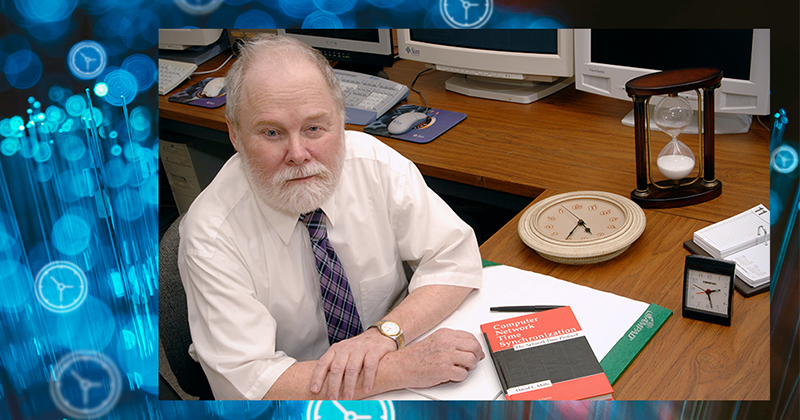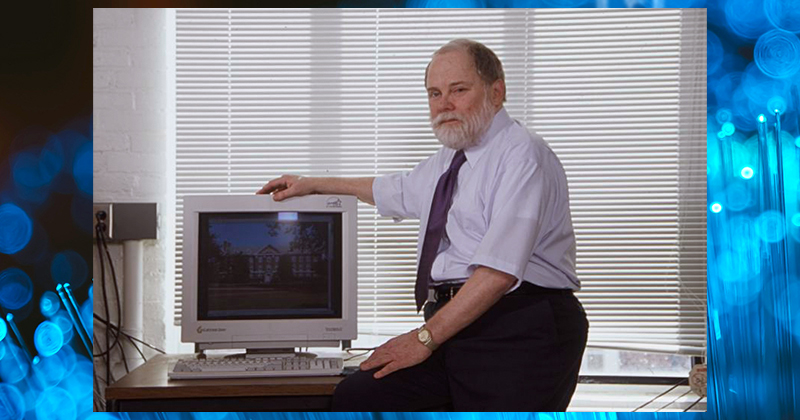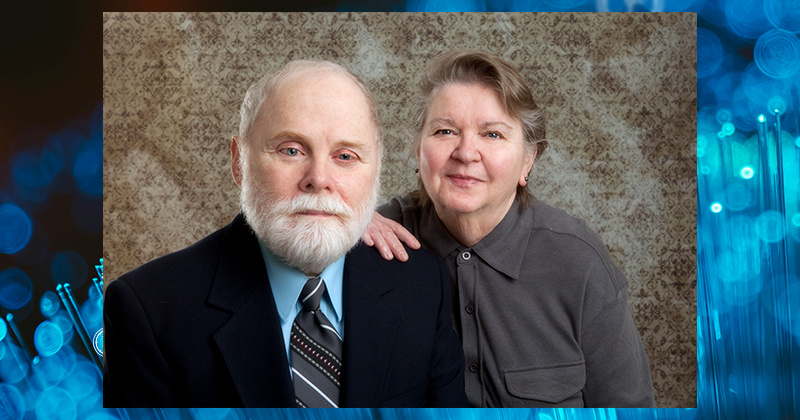


In Memoriam: David Mills
Photos by Sander Weeteling and courtesy of University Archives March 07, 2024
Retired UD engineering professor remembered for being an early internet pioneer thanks to his innovative approach to synchronized time keeping
An on-campus secular memorial for Dr. Mills will take place at Mitchell Hall on March 11, 2024, at 3 p.m.
Dr. David Mills, a retired University of Delaware professor known as the “father time” of the internet, passed away on Jan. 17, 2024.
Dr. Mills, who held appointments in UD’s College of Engineering in the departments of electrical and computer engineering and computer and information sciences, is most well-known for developing the system that allows computers on a network to synchronize their time. Along with being a pioneer of the early internet, he is remembered for his curiosity, knowledge and enthusiasm.
Dr. Mills, who grew up in Oakland, California, was born with glaucoma and had significant vision problems since birth. After graduating from a high school for the visually impaired in San Mateo, California, he went on to complete his undergraduate and graduate studies at the University of Michigan, earning bachelor’s degrees in engineering science and mathematics as well as master’s degrees in electrical engineering and communication sciences before completing his doctorate in computer and communications science in 1971.
Mike Alexander, former member of the research staff of the University of Michigan's Computing Center and Information Technology Division Research Systems, worked with Dr. Mills from 1965 until 1971. They collaborated on what would become the Michigan Terminal System (MTS), one of the world’s first shared computers, with Dr. Mills supporting the design and construction of the MTS Data Concentrator.
“The Data Concentrator was almost certainly the first non-IBM device to be connected to an IBM channel, and we spent many hours together debugging the interface,” said Alexander, adding that he was amazed at how much Dr. Mills was able to achieve without modern vision aids. “He was one of the most interesting and smartest people I have ever known, and he will be missed by all who knew him.”
Scott Gerstenberger, also a former member of the technical staff and later an associate director at Michigan’s Computing Center who worked with Dr. Mills, remembered him as curious, quirky and talented.
“I first met Dave in the context of radio station involvement. I was involved in making the only known audio recording of John F. Kennedy’s remarks at the entrance to the Michigan Union while he was running for president, when he first mentioned the idea of the Peace Corps,” Gerstenberger said. “That recording was made using a small FM band transmitter sitting on the top of a step ladder near the Union entrance and transmitting to WCBN’s FM receiver around the corner in South Quad, where it was recorded in the control room. The FM transmitter was designed and made from individual components by Dave Mills.”
After earning his doctorate, Dr. Mills taught computer science at the University of Maryland and the University of Edinburgh before joining the COMSAT Corporation from 1977 until 1982. It’s here where Dr. Mills began his work on the Network Time Protocol (NTP), which synchronizes computer systems clocks within networks and was first implemented in 1985. Today, the latest version of NTP continues to ensure that millions of computers and other internet-connected devices worldwide, from mobile phones to air traffic control centers, run “on time” and ensure that our interconnected world runs smoothly.

Dr. Mills’ most important publications on this subject include “Internet Time Synchronization: The Network Time Protocol” in IEEE Transactions on Communications, which described the protocol and how its architecture and algorithms maintained distributed timekeeping, followed up by Computer Network Time Synchronization: the Network Time Protocol on Earth and in Space, a textbook that describes the principles of time synchronization, how NTP works, and the development of the protocol over time.
Charles Boncelet, professor of electrical and computer engineering with a joint appointment in computer and information sciences, was a collaborator of Dr. Mills and described him as a tinkerer with a passion for clocks and timekeeping.
“He took a problem that few realized was a problem, synchronizing clocks, and made it his life's work,” Boncelet said. “Others took up the problem of time synchronization, but Dave was far ahead of them. Dave's actual experience deploying NTP worldwide showed him the numerous practical problems that arise in the real world.”
In addition to NTP, Dr. Mills also invented “The Fuzzball,” the first modern router and application server on the Internet, while working at the University of Maryland. Six fuzzball routers were used in 1986 to build the first 56 kilobits per second National Science Foundation Network (NSFNET) backbone, a precursor to today’s internet, which enabled the first Internet protocol (IP) suite to be developed.
After working at Linkabit Corporation from 1981 until 1986, Dr. Mills joined UD as a professor. He taught graduate and undergraduate courses in data communications, network protocols, computer security, electronic circuit analysis, digital systems design and computer architecture. His research program, which focused on computer networks, security, communication systems and digital radio communications, was funded by the Defense Advanced Research Projects Agency (DARPA), the National Science Foundation (NSF), the National Aeronautics and Space Administration (NASA), and the U.S. Navy and Army.
Dr. Mills retired from UD in 2008 but continued to teach as an emeritus professor. In addition to his more than 20 years of service here at UD, he and his wife Beverly also provide financial support to mid-career women through the David L. and Beverly J.C. Mills Career Development Chair. This named professorship rotates between the electrical and computer engineering and the computer and information sciences departments and is currently held by Sunita Chandrasekaran.

The impact of Dr. Mills’ work was recognized by several professional societies — Mills was a member of the National Academy of Engineering, the Internet Society (ISOC), the American Association for the Advancement of Science (AAAS) and he was a Fellow of both the Association for Computing Machinery (ACM) and the Institute of Electrical and Electronic Engineering (IEEE). IEEE also recognized Dr. Mills in 2013 with the IEEE Internet Award, one of the society’s Technical Field Awards, “for significant leadership and sustained contributions in the research, development, standardization, and deployment of quality time synchronization capabilities for the internet.”
Outside of his career’s many achievements, Dr. Mills’ hobbies included running an amateur radio station (W3HCF) out of his home in Newark. He was also a member of the American Radio Relay League, the Radio Society of Great Britain and the Amateur Satellite Organization.
“Dr. Mill's contributions to NTP are recognized across the field and the globe,” said Kenneth Barner, Charles Black Evans Professor of Electrical Engineering. “Additionally, he was a great long-time colleague in the ECE department as well as a great friend and neighbor — everyone recognized his ham radio antenna in the neighborhood. I thought of him regularly, as I was honored to occupy his office once he retired. His contributions set a high bar in the ECE department and profession.”
Dr. Mills is survived by his wife Beverly Mills, his daughter Eileen Schnitzler, his son Keith Mills and his brother Gregory Mills. To learn more about Mills, read the article published by the University of Michigan’s College of Engineering.
Contact Us
Have a UDaily story idea?
Contact us at ocm@udel.edu
Members of the press
Contact us at 302-831-NEWS or visit the Media Relations website

